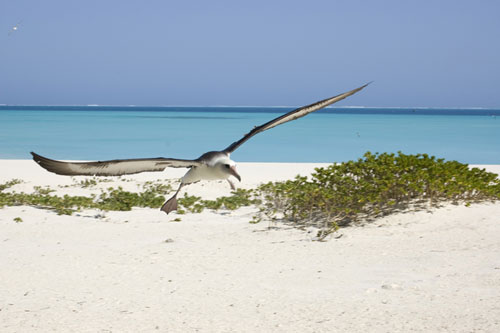Ann Edwards (Alaska Fisheries Science Center, Seattle, Washington, USA) and colleagues have published open-access and online in the journal PLoS ONE on the foraging strategies of Laysan Albatrosses Phoebastria immutabilis in relation to fisheries as deduced from stable isotope analyses.
The paper’s abstract follows:
“Fatal entanglement in fishing gear is the leading cause of population decline for albatross globally, a consequence of attraction to bait and fishery discards of commercial fishing operations. We investigated foraging strategies of Laysan albatross (Phoebastria immutabilis), as inferred from nitrogen and carbon isotope values of primary feathers, to determine breeding-related, seasonal, and historic factors that may affect the likelihood of association with Alaskan or Hawaiian longline fisheries. Feather samples were collected from live birds monitored for breeding status and breeding success on Midway Atoll in the northwestern Hawaiian Islands, birds salvaged as fisheries-bycatch, and birds added to museum collections before 1924. During the chick-rearing season (sampled April-May), means and variances of stable isotope values of birds with the highest, most consistent reproductive success were distinct from less productive conspecifics and completely different from birds caught in Hawaiian or Alaskan longline fisheries, suggesting birds with higher multi-annual reproductive success were less likely to associate with these fisheries. Contemporary birds with the highest reproductive success had mean values most similar to historic birds. Values of colony-bound, courting prebreeders were similar to active breeders but distinct from prebreeders caught in Alaskan longline fisheries. During the breeding season, δ15N values were highly variable for both contemporary and historic birds. Although some historic birds exhibited extremely low δ15N values unmatched by contemporary birds (< 11.2‰), others had values as high as the highest fishery-associated contemporary birds. During the non-breeding season (sampled July-September), isotopic variability coalesced into a more narrow set of values for both contemporary and historic birds. Our results suggest that foraging strategies of Laysan albatross are a complex function of season, breeding status, and multi-annual breeding success, factors that likely affect the probability of association with fisheries.

Laysan Albatross, photograph by James Lloyd
Reference:
Edwards, A.E., Fitzgerald, S.M., Parrish, J.K., Klavitter, J.L. & Marc D. Romano, M.D. 2015. Foraging strategies of Laysan Albatross inferred from stable isotopes: implications for association with fisheries. PLoS ONE 10(7): e0133471. DOI: 10.1371/journal.pone.0133471.
John Cooper, ACAP Information Officer, 18 August 2015

 English
English  Français
Français  Español
Español